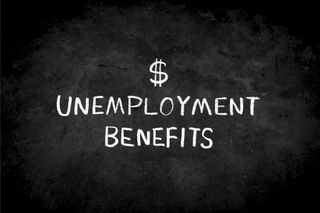
The federal government taxes unemployment benefits. But is unemployment taxable in your state? Here's what you need to know.
When you purchase through links on our site, we may earn an affiliate commission. Here’s how it works.

You can’t escape federal income tax on your unemployment benefits. But you may be wondering if unemployment is taxable at the state level. The answer to that depends on where you live. That’s because some states consider these benefits taxable income, while others don’t.
Before turning to states that tax unemployment benefits, it’s important to know that unemployment benefits are taxable at the federal level. The IRS considers unemployment benefits taxable income, and you must claim the benefits as such when you file your federal income tax return.
Note: You can opt to have a portion of federal taxes withheld from your state unemployment benefit payments. However, you request this since withholding is not automatic for unemployment benefits. You will receive a Form 1099-G containing information showing the total amount of your benefit payments and withholding for a given year.
Be a smarter, better informed investor.
Save up to 74%
Profit and prosper with the best of expert advice on investing, taxes, retirement, personal finance and more - straight to your e-mail.
Profit and prosper with the best of expert advice - straight to your e-mail.
Which states don’t tax unemployment benefits? Unemployment benefits are taxable to some degree in most states. But you won’t have to pay state income tax on these benefits if you live in one of the states listed below.
These states either don’t impose tax on personal income or exempt unemployment income from tax.

If you collect unemployment in any other state, you may find yourself with a bigger-than-expected tax bill when you file your state return. Here’s how the states that do tax unemployment will tax your benefits in 2023.
Arizona taxes unemployment benefits at the same rate regular income is taxed. However, there’s a good chance you’ll pay less income tax in Arizona this year since the state now imposes a flat 2.5% tax rate, regardless of how much you earn (or collect in unemployment).
Arkansas considers your unemployment benefits taxable income, but the state doesn’t have a flat income tax rate like Arizona does. That means how much tax you pay depends on which tax bracket you fall into.
Colorado will tax your unemployment as regular income, but there’s no need to worry about which tax bracket you fall into. You’ll pay a flat 4.4% Colorado state income tax rate in 2023, regardless of your income level.
Delaware will tax your unemployment benefits, but how much will you pay? That depends on your yearly income. You’re subject to a Delaware income tax rate of at least 2% if your taxable income is above $2,000. But you could owe the state more.
Unemployment benefits are taxable in Georgia, and most filers will pay a 5.75% state income tax rate. That’s because this rate applies to filers with more than $7,000 of income ($10,000 for joint filers).
You can’t escape state taxes in Hawaii. The state taxes unemployment benefits to the same extent as the federal government. There are 12 income tax brackets in Hawaii. The lowest bracket comes with a 1.4% tax rate, but most Hawaii residents will pay more.
Idaho is another state that taxes unemployment benefits, and you’ll pay the same tax rate, regardless of your income. That’s because Idaho moved to a flat income tax rate of 5.8% for all taxable income over $2,500 ($5,000 for joint filers) in 2023. That’s good news if you’re a high-earner, but the flat tax rate means people with lower incomes may pay more than they would in other states.
Unemployment benefits are taxed in Illinois, and it is another state with a flat tax rate. However, taxpayers in Illinois pay nearly one percent less than Idaho residents. Illinois’ flat tax rate of 4.95% creates a lower tax burden for people with higher incomes, but taxpayers with lower incomes may pay more tax in Illinois than in other states.
Indiana taxes unemployment benefits, but residents are luckier than some. Indiana imposes a flat tax rate of 3.15%, which is much lower than in many states. That rate is also lower than Indiana's tax rate last year.
Unemployment income is fully taxable in Iowa, so be prepared for a possible tax bill when you file your state tax return. Even if your taxable income is low, you could be taxed at a 4.4% tax rate, which is high considering how low tax brackets are taxed in most states.
Unemployment benefits are subject to Kansas state income tax, but how much will you pay? That depends on how much money you make in 2023. However, tax brackets in the state max out at 5.7%, which is low compared to many states.
Kentucky taxes unemployment benefits to the same extent as federal law, but you won’t have to guess your state tax rate. That’s because Kentucky imposes a flat income tax rate of 4.5% for 2023. This tax rate could be reduced to 4%, but there are no guarantees.
In Louisiana, you’ll pay between 1.85% and 4.25% on your unemployment benefits. That’s because the Pelican State taxes unemployment to the same extent as the federal government. So, what state tax rate will you pay? It depends on your total yearly income.
Maine taxes unemployment benefits, and income tax rates are higher for many filers in Maine than in other states. That’s because the lowest tax bracket in Maine is 5.8%. That’s higher than the highest tax rate in some states.
The good news is Maryland’s income tax rates max out at 5.75%. The bad news is the state taxes income under just $1,000 at 2%, including unemployment benefits. How much Maryland income tax will you pay?
Massachusetts taxes unemployment benefits, but the state will tax you a flat 5% income tax rate unless you made over $1 million in 2023. In that case, you must pay the Massachusetts millionaire’s tax, which went into effect this year.
Unemployment income is taxable in Michigan, but figuring out how much state tax you owe is easier in Michigan than it is in most other states. That’s because the Wolverine State imposes a flat income tax rate.
Minnesota taxes unemployment benefits, and to make matters worse, the state imposes higher income tax rates than most. The lowest state tax rate is 5.35% and applies to income up to $30,070 ($43,950 for joint filers). If your income is higher, you will pay even more.
Mississippi taxes your unemployment benefits at a flat 5% income tax rate, but there is good news for residents in the future. The 5% tax rate is set to reduce over the next few years, thanks to recent legislation passed by lawmakers. Here’s what Mississippians will pay — and when:
In Missouri, your unemployment benefits are considered taxable income. However, many state residents will pay less income tax this year. That’s because Missouri’s top tax bracket was recently reduced from 5.3% to 4.95%.
Nebraska is another state that taxes unemployment benefits, and many taxpayers fall into the state’s top income tax bracket. That’s because the highest bracket applies to taxable income over $35,730 (more than $52,980 for joint filers). The rate for the top tax bracket is set to gradually reduce over the next few years though. Here’s what Nebraskans who fall into this bracket will pay in the coming years.
New Mexico income taxes on unemployment benefits range from 1.7% to 5.9% Single filers making $16,000 or are subject to a tax rate up to 4.7%. Joint filers can make up to $24,000 without surpassing the 4.7% rate. Higher earners pay even more taxes in New Mexico.
You can’t escape paying income tax on unemployment benefits in New York. The Empire State considers your unemployment payments taxable income, and the state has nine income brackets. That means how much state taxes you pay can vary greatly, depending on your annual taxable income.
There’s some good news and some bad news when it comes to Norththe Carolina unemployment tax. The state currently taxes these benefits at a flat tax rate of 4.75%. That is high for taxpayers with lower incomes but low for the highest-earning residents (compared to other states).
North Dakota taxes unemployment benefits, but many residents won’t pay a dime to the state this year. That’s because recently enacted legislation exempts income up to $41,775 for single filers. Other taxpayers catch a break, too.
Ohio considers unemployment benefits taxable income, but the state imposes lower tax rates than many other states. For example, top earners in Ohio pay a 3.75% state income tax rate. This was recently reduced from the highest 2022 rate of 3.99%.
Oklahoma taxes unemployment benefits, and most residents will pay the top income tax rate of 4.75%. That’s because this tax rate applies to taxable income over $7,200 ($12,200 for joint filers). If your taxable income is below this amount, here’s you much Oklahoma income tax you might pay.
Oregon taxes unemployment benefits. And to make matters worse, the state has higher income tax rates than most. Depending on your annual taxable income, you can expect to pay an Oregon tax rate between 4.75% and 9.%.
Unemployment benefits are considered taxable income in Rhode Island, and you may wind up paying a 3.75% state income tax rate, even if you made very little. The lowest tax bracket of 3.75% applies to taxable income below $73,450.
South Carolina taxes unemployment income and most state residents are subject to the highest income tax bracket of 6.5%. That’s because this tax rate applies to taxable income over $16,040. Here’s how much you might pay in South Carolina income tax if your income falls below this threshold:
If you collect unemployment benefits in Utah this year, you’ll pay state income tax on the payments you receive. However, you won’t have to figure out which tax bracket you fall into. Utah has a flat income tax bracket of 4.65%. That means you’ll pay a 4.65% tax rate whether you make $20,000 or $200,000 in 2023.
Vermont taxes unemployment as taxable income, but it’s possible to escape Vermont’s state income tax if your income falls below specified thresholds set by the state. For 2023, income below $3,500 (below $10,538 for joint filers) is tax-exempt. Here’s how much you’ll pay if you make more money this year.
West Virginia taxes unemployment income to the same extent it’s taxed by federal law. However, West Virginia income tax rates max out at 5.12%, which is lower than the highest tax brackets in many states. The 5.12% tax bracket applies to taxable income over $60,000.
(Note: The income thresholds for married filing separately taxpayers are lower.)
Unemployment is taxable in Wisconsin. However, some residents can exclude a portion of their payments from taxable income for state tax purposes. To find out if you can exclude any of your unemployment benefits, complete Wisconsin Schedule SB. Wisconsin has three income tax brackets.
Profit and prosper with the best of Kiplinger's advice on investing, taxes, retirement, personal finance and much more. Delivered daily. Enter your email in the box and click Sign Me Up.
By submitting your information you agree to the Terms & Conditions and Privacy Policy and are aged 16 or over.